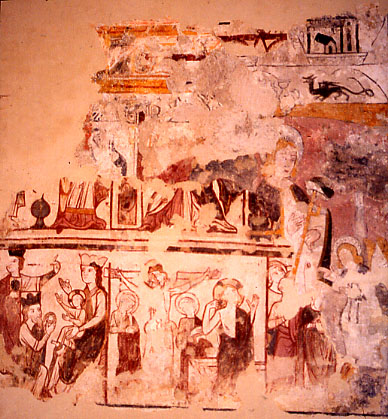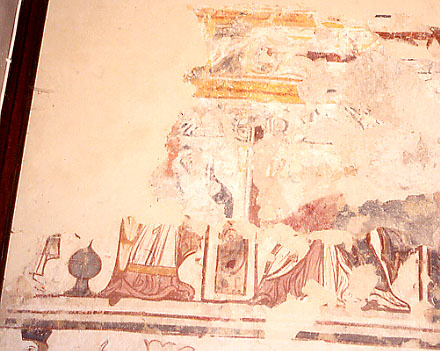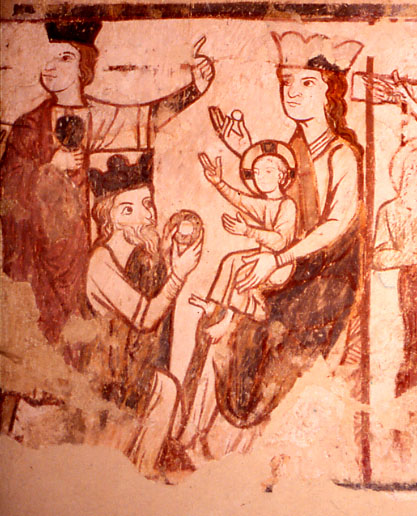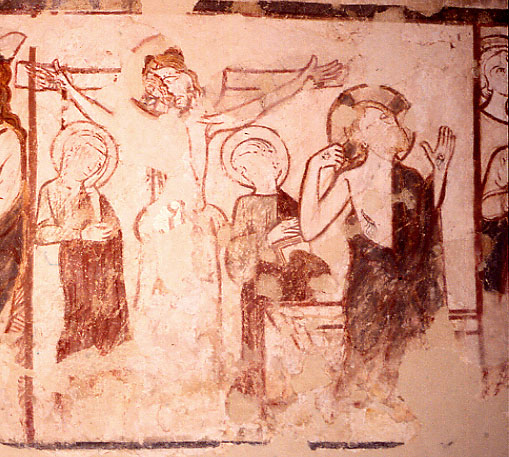Pinvin, Worcestershire (†Worcester) C.13 &15
The Annunciation, Visitation, Adoration of the Magi, Passion Cycle and St Roch

The subjects at the east end of the south wall at Pinvin are arranged in such a way that dealing with them separately would be confusing, so all five are dealt with together here.
Different scenes are separated in various ways, and across the top of the painting is a broad, gold-bordered strip which seems to be purely ornamental, although there are some small buildings, painted in black, at the top right. In view of what is lower down, this might be intended for any, or even all, of the locations in which the events painted took place – from Nazareth to Jerusalem. Alternatively, these might be simply decorative, as the small, very well painted black dragon (said to have been red originally) at the upper right seems to be.

The subject paintings begin below this, with the remains of an Annunciation (detail, left) at the left of the top tier. The Virgin is on the right. Some of her gown and mantle (lined with the high-status fur called vair as Tristram pointed out)¹, a fragment of Gabriel’s robe at the far left, and the lower part of the lily-pot between are visible. A broad vertical band with scrollwork, perhaps intended to suggest the wall of a house, separates the Annunciation from the next scene to the right. This is the Visitation, and the skill with which the robes of Mary and Elizabeth are painted shows that this would have been a fine example of the subject once, although only the lower part is visible now.

The Nativity story may originally have continued to the right, perhaps with the Annunciation to the Shepherds, but the next incident visible, in much better condition, is the Adoration of the Magi (detail, right), in the lower tier at the left, below the Annunciation. The Virgin sits at the right, crowned, and holding the infant Christ, who has the tripartite halo, on her lap. In her right hand she hold a small circular object – a pearl? – but this is not mentioned in Tristram’s description at all. It may or may not be one of the Magi’s gifts, and the same detail appears in an early painting of the Adoration of the Magi in France, at Asniéres-sur-Végre [Sarthe].
One of the Magi, a king, and no doubt the eldest of the three, kneels to receive Christ’s blessing and present his gift, a disc-shaped object, probably made of gold. Behind him stands a much younger man, with what may be a crown on his head, holding a vial for the frankincense or myrrh and pointing inwards, probably for the benefit of the third Magus, who is no longer visible but is described by Tristram as bearded, crowned and raising his hands in wonder. The Adoration is separated from the next scene to the right, the Crucifixion and Resurrection, (detail, below left) only by a narrow vertical line.

The Crucifixion shows the Virgin, her head propped on her hand in sorrow, and St John with a book on the other side of the Cross. There are some puzzling details – two curving bulges on either side of the Cross halfway down it are hard to account for, unless there were once sorrowing figures, such as Mary Magdalene, here. Half of Christ’s face is effectively obscured, perhaps by a deliberately-painted attempt to suggest a mask of blood, or perhaps for some other reason. Once again, it is hard to be sure what is and is not the product of restoration².
Most unusually, the Resurrection is shown in the same ‘compartment’ as the Crucifixion, and even more unusually, Christ stands upright in front of the rectangular tomb, arms raised. There is no sign of the Vexillum or of another figure. This may be an attempt on the part of the painter to avoid the vexing problem of showing a figure climbing in a dignified way out of a box-like structure. The diffficulties presented by perspective and by the convincing articulation of the limbs were considerable, and in any medieval painting of the subject it is usually clear that the painter is trying desperately not to present Christ as a clumsy, distorted figure, scrambling gracelessly out of the tomb.
![Pinvin, St Roch/Ascension [69KB]](images/pinvin5.jpg)
To the right of the Crucifixion/Resurrection is part of the Ascension (right), with two disciples, one looking up, others implied, and a front-facing figure in draperies who is probably the Virgin, but this has been overpainted in the 15th century with a scene on a much larger scale showing St Roch, a fairly recent saint who died in about 1380. Roch, a hermit, spent much of his life on pilgrimages, contracting plague, of which he was miraculously cured, in Piacenza and thus becoming a patron of pilgrims and plague victims alike. He is occasionally painted on English screens, but I have not seen another wall painting of him in England.
Both his areas of patronage are indicated here. Roch himself is the large figure at the left, his pilgrim’s hat carried on the end of his staff. With his left hand he holds open his cloak to reveal the plague-sore on his leg. A bending Angel, much smaller, is at the right, pointing out the sore, with a tree (apparently belonging to this painting and not the 13th century series) above. The St Roch painting must be a fairly recent discovery, since the main books on the subject do not mention it, but it is very useful evidence of the preoccupations colouring medieval life and of the fact that any saint might crop up anywhere. This link will take you to an Italian example at Caltignara [Novara, Italy]. Roch is the figure on the right, dressed as a pilgrim and indicating the plague sore just above his knee.
Links to other pages for Lives of the Virgin can be found below. Other links relevant to these paintings are the Passion Cycle, the Infancy of Christ and the Lives of the Saints.
Website for St Nicholas, Pinvin
¹ Tristram II, p.591
² Neither Tristram nor Caiger-Smith mention these details. There is an article and reproduction in a rather obscure journal of 1856, which I will try to track down.